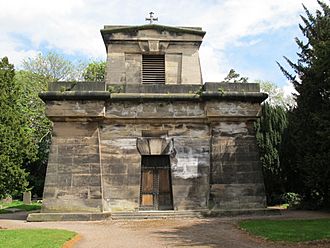Trentham Mausoleum facts for kids
Quick facts for kids Trentham Mausoleum |
|
|---|---|
 |
|
| Alternative names | Sutherland Mausoleum |
| General information | |
| Type | Mausoleum |
| Architectural style | Neo-classical, Egyptian Revival |
| Location | Trentham, Stoke-on-Trent, England |
| Construction started | 1807 |
| Completed | 1808 |
| Client | George Leveson-Gower, 1st Duke of Sutherland |
| Owner | Stoke-on-Trent City Council |
| Technical details | |
| Material | Ashlar stone |
| Design and construction | |
| Architect | Charles Heathcote Tatham |
| Designations | Grade I listed |
The Trentham Mausoleum is a very old and important building in Trentham, Stoke-on-Trent, England. It's a special kind of tomb built as the final resting place for the Dukes of Sutherland and their family, the Leveson-Gowers. This building is so important that it's a Grade I listed site, meaning it's protected because of its special history and design.
A Look Back: How the Mausoleum Was Built
The Trentham Mausoleum was built a long time ago, between 1807 and 1808. It was ordered by George Leveson-Gower, who was the 2nd Marquess of Stafford before becoming the 1st Duke of Sutherland.
The person who designed this unique building was an architect named Charles Heathcote Tatham. He was a friend of Elizabeth, the Duke's wife. Charles Heathcote Tatham also designed other buildings, like a lodge and bridges, at the nearby Trentham Hall.
What Does It Look Like?
The mausoleum is made from a type of cut stone called ashlar. Its design mixes two cool styles: neo-classical and Egyptian.
You'll notice the corners of the building have striped, tall structures that look a bit like Egyptian pylons. These might have been inspired by Charles Heathcote Tatham's time in Paris, where this style was popular in the late 1700s.
The entrance door is quite small. Its doors are decorated with fancy wrought-iron designs, and there's a heavy stone beam, called a lintel, above them. On top of the whole mausoleum is a small tower with windows that have louvres (slanted slats) and a roof shaped like a pyramid.
Above the doorway, you can see the family's coat of arms. There's also an inscription that says "MDCCCVIII". This is a Roman numeral for 1808, which tells us when the building was finished.
Protecting This Old Building
Over the years, people have become worried about the condition of the Trentham Mausoleum. Even though some urgent repairs have been done, as of 2021, it is still on the Heritage at Risk Register. This means it's a historic building that needs special care to make sure it lasts for many more years.

